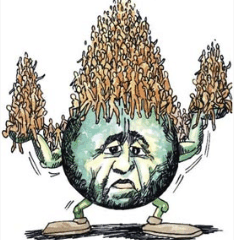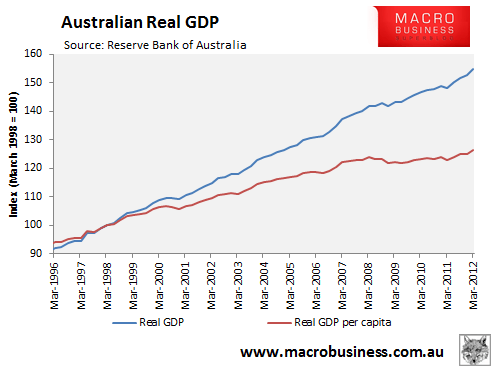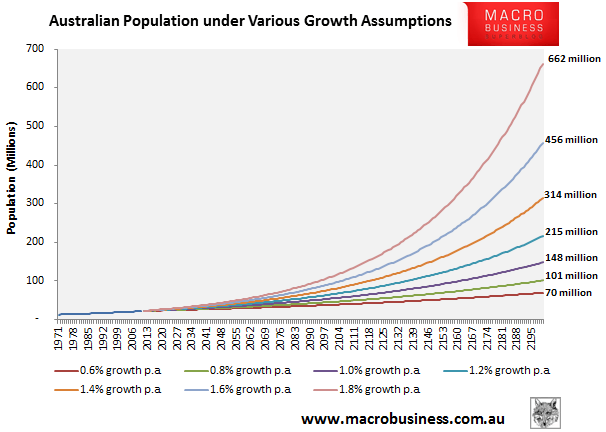
Yesterday, WAM Capital’s Matthew Kidman wrote a article in Business Day arguing that Australia must increase population growth, in particular immigration, or it risks destroying the economy. Let’s take a look.
THE first policy a new federal government should dust off when elected next year is ”Big Australia”…
The reality is though that without population expansion Australian economic growth will stall, placing pressure on company valuations and the performance of the sharemarket. Live examples of this already exist in Japan, Italy and Greece. Australia needs a demographic policy that involves targeted population growth.
According to the Australian Bureau of Statistics, the economy grew at an annual pace of 3.2 per cent in the 1990s of which 1.5 per cent was contributed by population growth. In the first decade of the new century, the local economy ratcheted up its growth to just under 4 per cent per year of which population growth can be credited with 1.8 per cent.
As is well documented, the Australian population, like many other Western nations, is getting older.
In the latest census released last month, it stated that the median age of Australia was 37 years old, up five years in two decades. This is not in itself a concern given that the working population, defined as those people aged between 15 and 65 years, actually increased as a percentage of all people during the same period. The working population is the productive component of society.
This, though, is about to change. It is estimated that by 2015 the median age of Australians will jump to 39 years and the working age will start to shrink from about 67 per cent of the population to 66 per cent. While it does not sound significant, it effectively means demographics will go from being supportive of economic growth to a handbrake.
The Reserve Bank of Australia released a report in 2010 analysing the impact of demographic change on economic growth in a number of countries. It concluded that from 2011 to 2020 demographic changes relating to population growth and the size of the working-age population would reduce economic growth by a full 1 per cent per year in Japan. In the prior decade it had contributed a positive 1.1 per cent.
That is enormous burden to carry for a country that is struggling to grow because of the Japanese penchant for saving instead of spending…
A study by the Federal Reserve Bank of San Francisco in 2011 said the ageing population was already having a significant impact on the sharemarket, with the price-to-earnings multiple investors are willing to pay for equities already falling as the median age increases.
Correct me if I am wrong, but isn’t the key purpose of economic policy to increase the welfare of all Australians, not to boost company valuations and asset prices?
From a narrow economic perspective, population growth (immigration) is good only if it raises the real average incomes of the pre-existing population (e.g. GDP per capita). While it is true that Australia’s high population growth over the second half of the 2000s boosted Australia’s real GDP (more labour inputs, other things equal, means more outputs), there is little empirical evidence to show that GDP per capita increased due to population growth. In fact, as the below chart shows, real GDP per capita has flat lined since 2007. So while the economic pie has increased in size since 2007, because of high population growth, everyone’s share of that pie has remained relatively stagnant!

Back to the article.
Australia’s population has grown approximately 1.4 per cent a year over the past 20 years. If this rate continued to 2050, then Australia’s population would hit 38 million, some 3 million more than what Rudd’s Big Australia would contain. So fears of the population growing out of control are ill-founded.
Clearly the author does not understand the nature of compound growth. Although a population growth rate of 1.4% sounds benign, it can have devastating consequences over a long time frame as the laws of exponential growth kick in (see below chart).

While you might think that the above chart is facetious, as population growth could easily be curtailed at some point in the future, the fact remains that there will always be vested interests pressuring governments to expand population growth in the face of an ever-ageing population.
The issue of an ageing population will need to be addressed at some point irrespective of the level of immigration. Simply importing more workers to cover the retirement of the baby boomers only delays the ageing problem, pushing the problem onto future generations. What will be the population boosters’ solution in 30 years time when current migrants grow old, retire and need taxpayer support? More immigration and an even larger Australia? In this regard, a “Big Australia” brought about by high immigration is just another ponzi scheme.
Back to the article.
The case for an orchestrated increase in the population gains currency when one considers the decline in the other two major contributors to economic growth – terms of trade and labour productivity.
The terms of trade have been a major driver of economic expansion in recent years, but it may have peaked recently with the crest of the mining boom. Meanwhile, labour productivity has been declining in relative terms for a decade with no signs of reversing.
Again, the author fails to differentiate between the overall growth in Australia’s GDP and growth in GDP per capita. The latter is most important as it affects living standards. And in the long-run, growth in per capita GDP is achieved through improvements in productivity, not through simply increasing the population.
Back to the article.
There are strong arguments against population growth, mostly concerning social change, environmental pressures and a lack of infrastructure. Policy must accommodate all of these concerns but none should be insurmountable if a detailed plan is constructed. In fact, if Australia managed to come to terms with its poor infrastructure, dearth of water and lack of geographical planning, the country would be significantly improved from a lifestyle and productivity perspective.
The problem with the above argument is that population growth, in itself, requires costly investments in new infrastructure (e.g. desalination plants) that would not be required absent population growth. And let’s not forget the other direct costs of population growth, including: environmental degradation, water scarcity, increased pollution and congestion, and lower housing affordability.
I do not hold much hope that these issues can be successfully managed given that Australia’s governments have failed so dismally in providing for the existing population, let alone millions of extra citizens. Further, it will be near impossible for Australia to reduce its carbon footprint and meet international pollution reduction targets with a substantially larger population.
Back to the article:
Finally, the world is forecast to grow from today’s 7 billion people to about 9 billion by 2060. After this it is expected to stall and then eventually shrink. With less than 23 million people, Australia, as a developed nation, should be expected to contribute to accommodating more people in a crowded world.
Sure, there are legitimate reasons for Australia to increase its humanitarian intake of refugees. But the author’s argument seems to directly contradict his earlier claim that Australia should aim for “targeted population growth”, presumably skilled migrants (thus depriving developing countries of these valuable workers):
Australia needs a demographic policy that involves targeted population growth… If a targeted population growth policy was implemented, it would require a careful selection process that kept the nation’s median age down and, more importantly, retained a similar-sized working population.
Let’s also not forget that Australia earns its way in the world mainly by selling its fixed mineral resources. More people means less resources per capita. A growing population also means that we must deplete our mineral resources faster, just to maintain a constant standard of living. This is hardly smart policy from an inter-generational welfare perspective.
Ultimately, it is living standards that matter most. And on this count, rapid population growth is a negative for Australia. That’s why views like Mr Kidman’s should be taken with a tablespoon of salt.
Twitter: Leith van Onselen. Leith is the Chief Economist of Macro Investor, Australia’s independent investment newsletter covering trades, stocks, property and yield. Click for a free 21 day trial.

